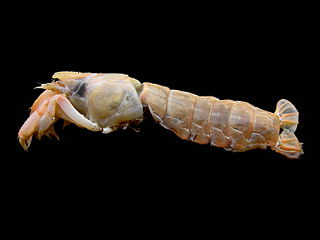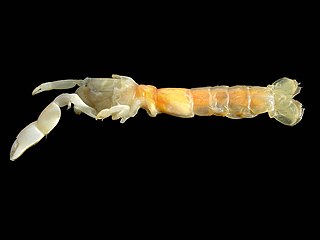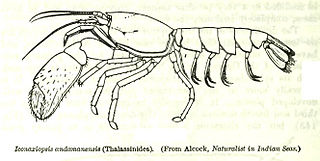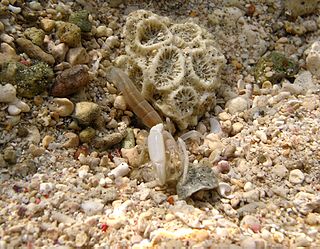
Axiidea is an infraorder of decapod crustaceans. They are colloquially known as mud shrimp, ghost shrimp, or burrowing shrimp; however, these decapods are only distantly related to true shrimp. Axiidea and Gebiidea are divergent infraoders of the former infraorder Thalassinidea. These infraorders have converged ecologically and morphologically as burrowing forms. Based on molecular evidence as of 2009, it is now widely believed that these two infraorders represent two distinct lineages separate from one another. Since this is a recent change, much of the literature and research surrounding these infraorders still refers to the Axiidea and Gebiidea in combination as "thalassinidean" for the sake of clarity and reference. This division based on molecular evidence is consistent with the groupings proposed by Robert Gurney in 1938 based on larval developmental stages.

Upogebia is a genus of mud shrimp, in the family Upogebiidae, containing the following species:

Callianassidae is a family of ghost shrimp crustaceans belonging to the infraorder Axiidea, within the order Decapoda.
Callianassa is a genus of mud shrimps, in the family Callianassidae. Three of the species in this genus have been split off into a new genus, Pestarella, while others such as Callianassa filholi have been moved to Biffarius. The genus is named after the Nereid of the Greco-Roman mythology.

Thalassina is a genus of mud lobsters found in the mangrove swamps of the Indian Ocean and western Pacific Ocean. Its nocturnal burrowing is important for the recycling of nutrients in the mangrove ecosystem, although it is sometimes considered a pest of fish and prawn farms.

Axiidae is a family of crustaceans belonging to the infraorder Axiidea, within the order Decapoda.

Eiconaxius is a genus of mud lobster that includes the following species:

Munida is the largest genus of squat lobsters in the family Munididae, with over 240 species.

Eumunida is a genus of squat lobsters. The majority of its species are from the Pacific Ocean and are as follows:

Agononida is a genus of squat lobsters in the family Munididae. In 2022, recognizing that the genus as then defined was paraphyletic, it was divided into three lineages: Agononidasensu stricto and two new genera, Garymunida and Hexamunida. Agononida is distributed in the Indian and Pacific Oceans.

Bathymunida is a genus of squat lobsters in the family Munididae, containing the following species:

Heteronida is a genus of squat lobsters in the family Munididae. They occur in the western Pacific Ocean.

Onconida is a genus of squat lobsters in the family Munididae, containing the following species:
Calliapagurops is a genus of mud shrimp containing two species:

Munididae is a family of squat lobsters, taxonomically separated from the family Galatheidae in 2010.

Dorphinaxius kermadecensis is a species of mud lobster native to the Norfolk Island, parts of New South Wales, and the Kermadec Islands of New Zealand. It is the only species in the genus Dorphinaxius. It has a depth range of 0–8 metres (0–26 ft).

Acanthaxius is a genus of mud lobster native to the Indo-Pacific oceans. It has a slender rostrum which is longer than the eyestalks, is spinose and has seven spines and has a depth range of 228–438 metres (748–1,437 ft).
Gourretiidae is a family of crustaceans belonging to the infraorder Axiidea, within the order Decapoda.

Callianideidae is a family of crustaceans belonging to the infraorder Axiidea, within the order Decapoda.

Ctenochelidae is a family of crustaceans belonging to the infraorder Axiidea, within the order Decapoda.















